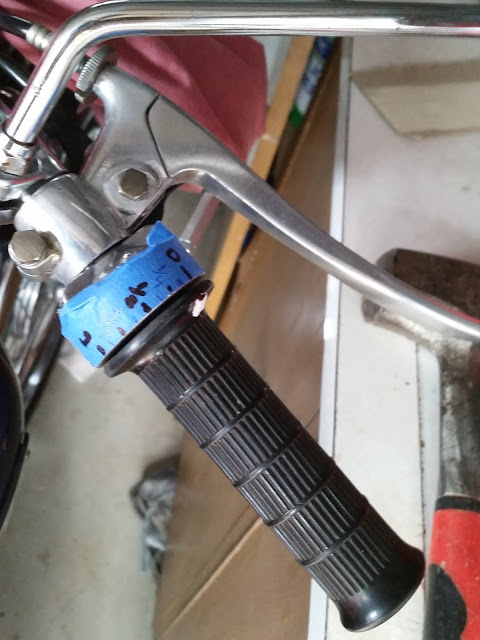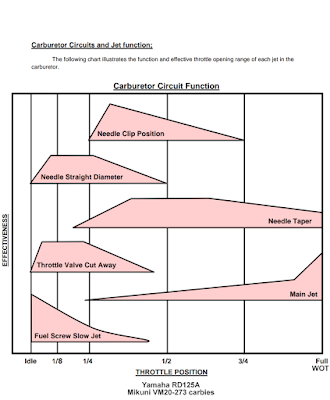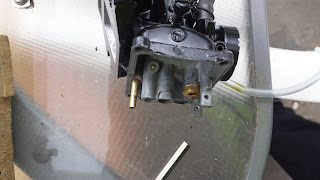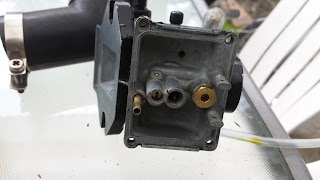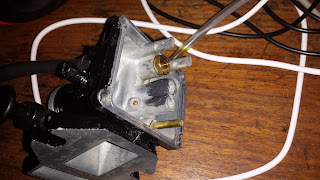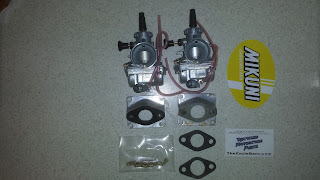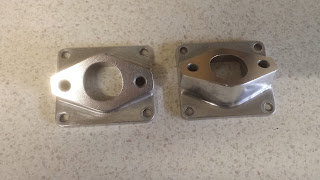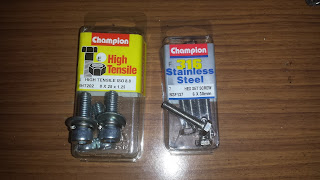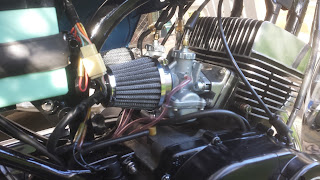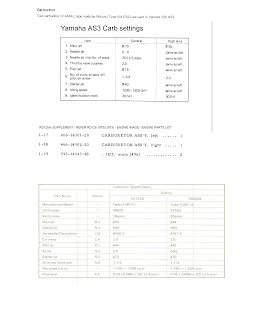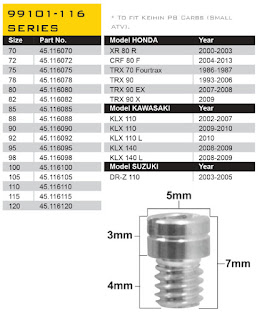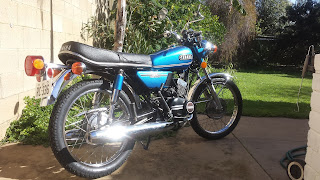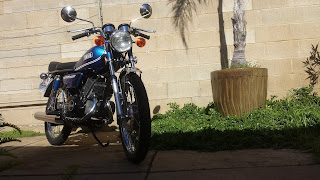After the basic tune of the Mikuni VM20 carbs (read make it running) I moved house and put the bike in the lounge for a couple of years. I was too busy with other personal and work related stuff to give it a perfect carb tune.
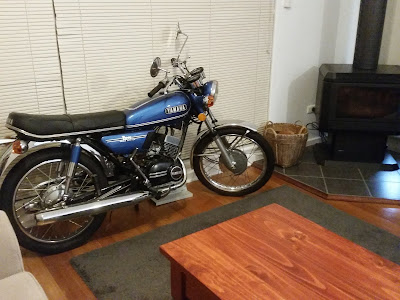 |
| Yamaha RD125A in lounge |
Now with the covid you're kind of doomed to stay home during your holidays but that's a good thing for fixing things around your house and I decided to take the old RD125A out for a proper carb tune.
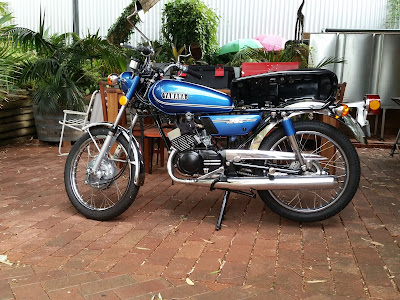 |
| Yamaha RD125 A Mikuni VM20 carb tuning |
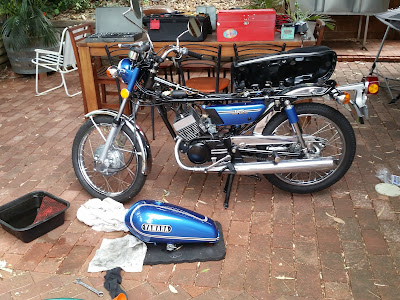 |
| Yamaha RD125 tuning mikuni carburetors |
The fuel tap was leaking again so I decided to buy a new one at HVCCycle. Exellent copy of the original one and fast shipping.
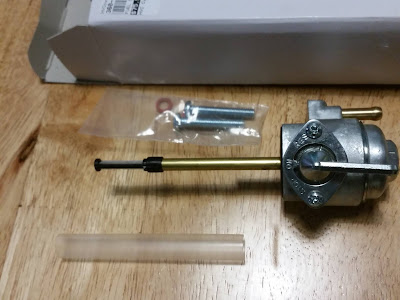 |
| Yamaha RD125A fuel tap |
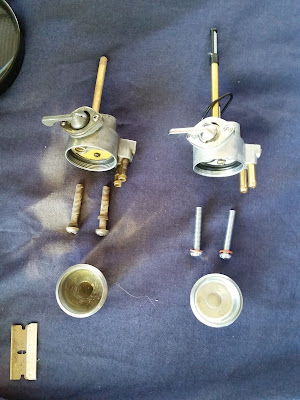 |
| Yamaha RD125 A fuel tap |
Most people say it's too risky to use the oil pump but mine is working fine and as the bike demands different levels of fuel/oil mix depending on speed/rpm it's better for the bike cause the pump will deliver and premix won't.
So what was in the two new Mikuni VM20-273 carbies when I put the bike away..
Pilot jet 22.5 (M28/1001)
Needle 4J13
Needle clip in 3rd (middle) position
Needle Jet O-6/N-6 (238/332 Series)
Main Jet 100 (4/042)
Air Jet 0.5
Slide Cutaway 2.0 (VM38/24)
Needle valve 1.5
 |
| Yamaha RD125 A Mikuni 22.5 pilot jet |
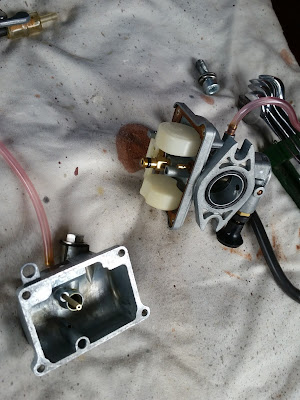 |
| Yamaha RD125 A Mikuni VM20-273 inside |
The bike idled ok but I noticed the spark plugs were getting a bit wet after a while. So time for a leaner pilot jet. I tried the 20 and ended up with 17.5 pilot jets. When the engine is cold you need the choke to get it running otherwise it's too rich.
See youtube vid: https://youtu.be/UzTlYwpjJ-s
The carbs were only roughly synchronized 5 years ago so after fitting the new pilot jets I started re- synchronizing the 2 Mikuni carburetors.
First look at the carb slides. They should move simultaniously up and down and be at the same height all the time. If not you can adjust it with the cable adjuster screw on top of the carbie. Another good way to check this is with the icepop stick trick, stick two wooden ice lolly sticks underneath the carb slides (engine not running) and move the throttle. If everything is ok they will move simultaniously. A really small difference will be magnified by this trick so it's really accurate.
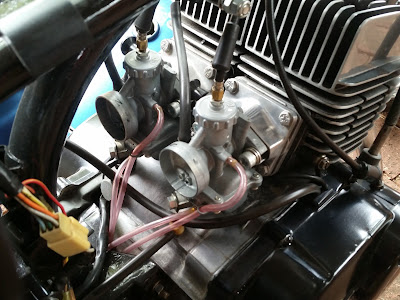 |
| Yamaha RD125 A with 2 Mikuni VM20 carbies |
After this you can set the air/mixture screws and idle screws. First put the air screw in the postion mentioned in the manual. eg. 1 1/2 turn out. Now get the bike on normal operating temperature and disconnect one spark plug so the bike is running on only one cylinder.
Turn the air screw 1/2 turn out and wait for the change in rpm for 10 seconds. If the rpm is increasing give it another 1/2 turn etc till the rpm starts to drop. Then turn air screw back to max rpm and give it 1/4 turn in after you've reached max rpm again (richer). Now set the idle speed screw on ca 1250 rpm. Do the same with the other carbie.
When both carbies are done let the engine run on both cylinders, the rpm is now too high so turn back both idle speed screws the same amount till it's ok around 1250 rpm.
When tuning carbies it's a basic rule to start with the pilot jet, followed by the main jet and finish with the needle. But that said you need to get the bike running first so the needle should be close to the right needle and close to the best needle clip position. Also the main shouldn't be too far off. The Yamaha AS3 runs on Mikuni carbies (different ones of course) and uses 75 main jets.
I can use that as a ballpark figure. It's probably gonna be a bit bigger as I run the carbies with two pod filters. On average a main jet needs to be 20% bigger when you use pod filters instead of the original air filter.
I also got rid of the fibre packing around the internal silencers cause it suffocated the engine too much. Now you need an even bigger main jet. So my guess was to start with a 95 or 100 or maybe even a 105 or 110. But the carbie can work different and pull maybe even more fuel from a smaller jet than the old mikuni on the Yamaha AS3. Time for some testdriving... well.. more then a couple :)
In order to tune the pilot, needle and main you need to divide your throttle in parts as the carbie has different circuits delivering fuel depending on the throttle position:
0 - 1/4 open is Pilot jet
1/4 - 3/4 open is Needle and needle clip position
3/4 - FT open is Main jet (FT=Full Throttle also called WOT= Wide OpenThrottle)
This way you can testride your bike in the throttle position area you're tuning.
Remember it is not the speed or rpm that dictates what's the main fuel supplier at that moment, only the throttle position counts.
The Mikuni VM20-273 carbies come with the needle clip in the middle position. There are 5 clip positions on this needle. The top position/groove is no.1 and the bottom one is called no.5. The leanest position is the top groove (no.1) and the richest no.5.
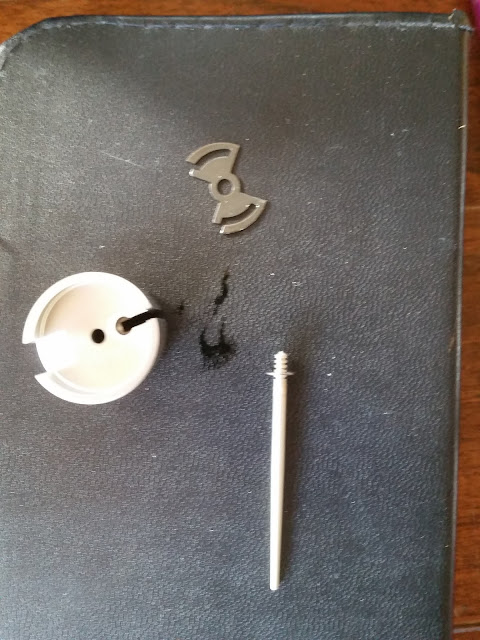 |
| Yamaha RD125A Mikuni VM20 needle and slide |
The bike was running but probably on the lean side in the midrange...it was kind of hard to get to the 3/4 FT position of the throttle without the bike hesitating, I had to go real slow with the trottle to get there.
So I decided to do a bit of basic needle clip tuning before looking into the best main jet and put the clips in the fourth groove which made the midrange a bit richer.. Way better pick up now.
Now I could easily get up to 3/4 throttle and tried a couple of different main jets from 85 till 100. 100 is still the best performing and maybe 105 is gonna be even better. But with all the main jet changes the rubber seal between the main jet screw and carbie started to wear out so I've to order a couple of new ones before I can finish the fine tuning of the main jet carbies.
Next thing I did was putting the needle clip in the n0.5 groove. There's a very light flat spot somewhere between going from 1/4 to 1/2. Probably a bit on the rich side but the pick up from a bit over 1/2 to just over 3/4 is perfect which made me think to put the needle clip back into the fourth groove and swap the 100 main jets for 105 main jets.
The reason behind this is that there is always an overlap between the pilot jet and needle and the needle and main jet.
I'll post an update when it's all done :)
Now waiting for the seals.
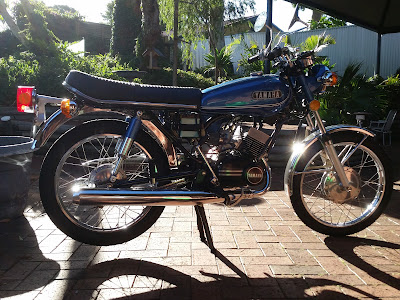 |
| Yamaha RD125A 1974 |
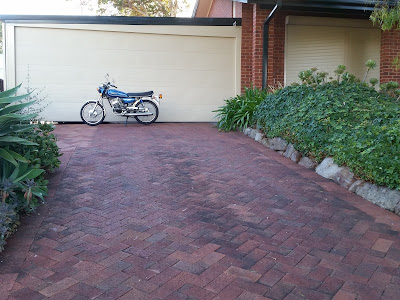 |
| Yamaha RD125A 1974 |
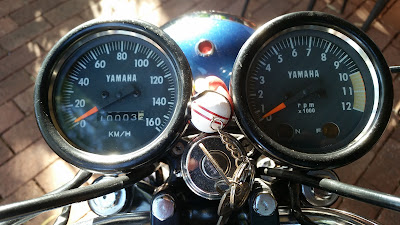 |
| Yamaha RD125A 1974 10.000 km |
While tuning the Mikuni carbies I ticked just over 10.000 km. That's around 212 km a year ;)
